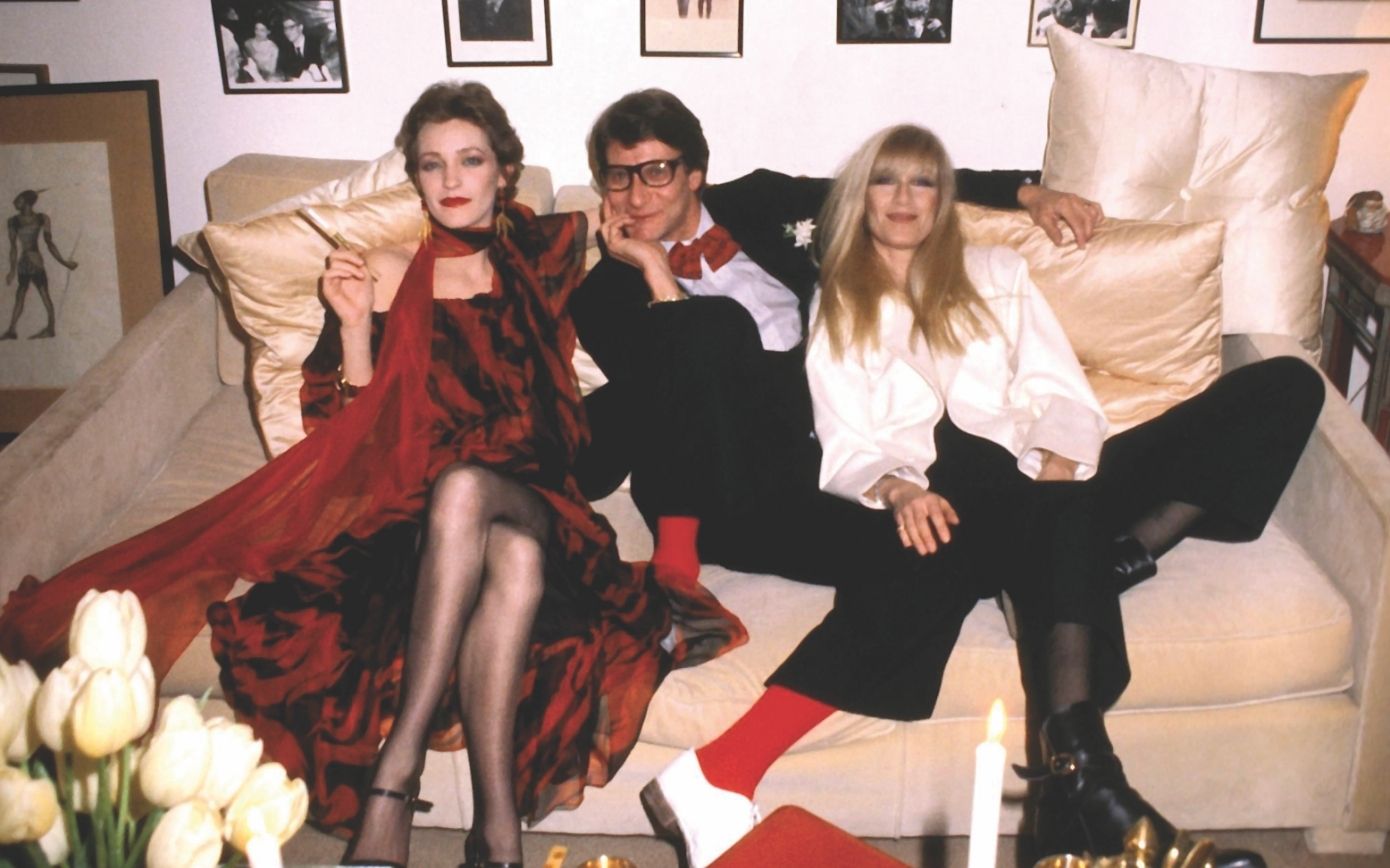In this piece by Christopher Petkanas, first published in THE GLOSS Magazine in 2018, he reveals how muse Loulou de La Falaise brought the spirit of Anglo-Irish bohemian style to Yves Saint Laurent’s Parisian salon …
Main featured image and below: Muses Loulou de La Falaise and Betty Catroux photographed with Yves Saint Laurent in 1979 in Yves’s home on rue de Babylon, Paris, by Guy Marineau.
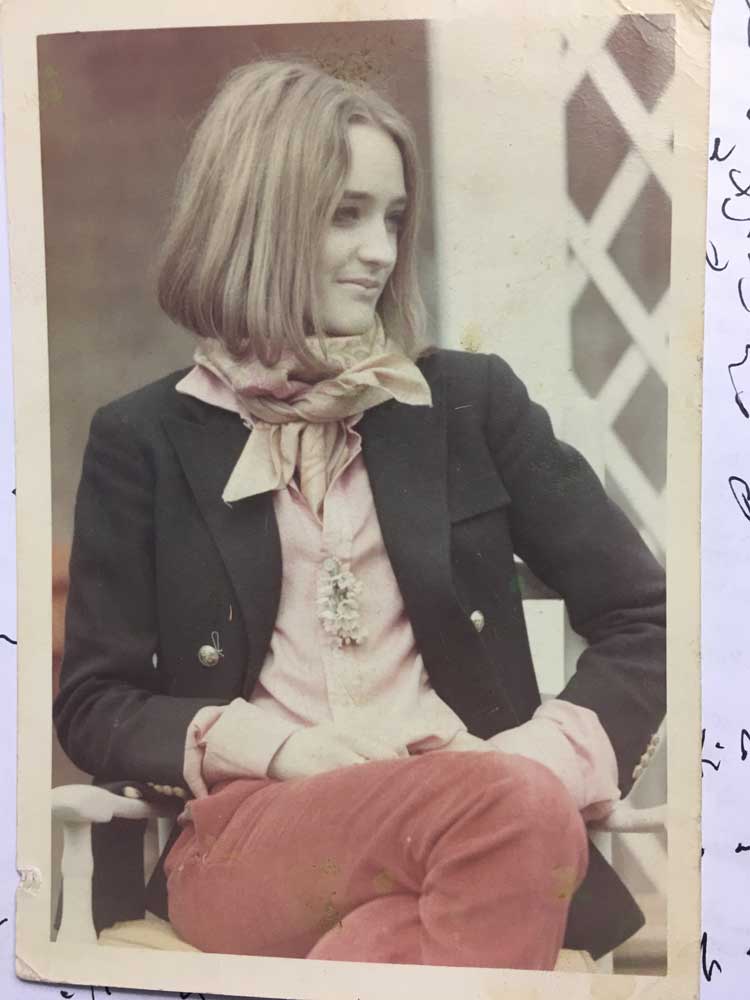
A Sloane-y looking Loulou in 1968, photographed at John Fowler’s home in Hampshire.
There is no record of Yves Saint Laurent setting foot in Ireland – everything he knew about it he knew from Loulou de La Falaise. Loulou had goodly amounts of Irish blood in her and was for a very brief (and reluctant) moment “the Madam FitzGerald”, wife of none other than the 29th and last Knight of Glin, Desmond FitzGerald.
Loulou brought the magic and mysticism of Ireland to the Saint Laurent studio as Yves’s right hand, muse, the only person he acknowledged as a creative collaborator in 45 years of dressmaking, and the virtuoso behind all those lip-smackingly flamboyant YSL accessories: cuffs stacked to the elbow, rings pleading under the weight of turquoise boulders, necklaces hung with nautilus shells the size of footballs. Loulou, who died of her own excesses in 2011 at 64, the same year as the knight and three years after Yves, chafed at “muse,” a term she thought made her sound like a self-involved socialite with too much time on her hands. After Saint Laurent retired in 2002, reasoning that she was “integral” to his oeuvre, she found a way to embrace it.
The man who put women in pants, trench coats, safari gear and tuxedos described having Loulou at his elbow for three decades, starting in 1972 at the height of her “hippie deluxe” period, as “a dream … It is important to have [her] beside me when I work on a collection … It has to do with her manner, her straightforwardness … I can’t explain her job … My working methods are lighter and less anxious now that Loulou is here … I trust her reactions. Sometimes they are violent but always positive … She’s the sounding board. I bounce ideas off her and they come back clearer and things begin to happen. She’s never wrong.”
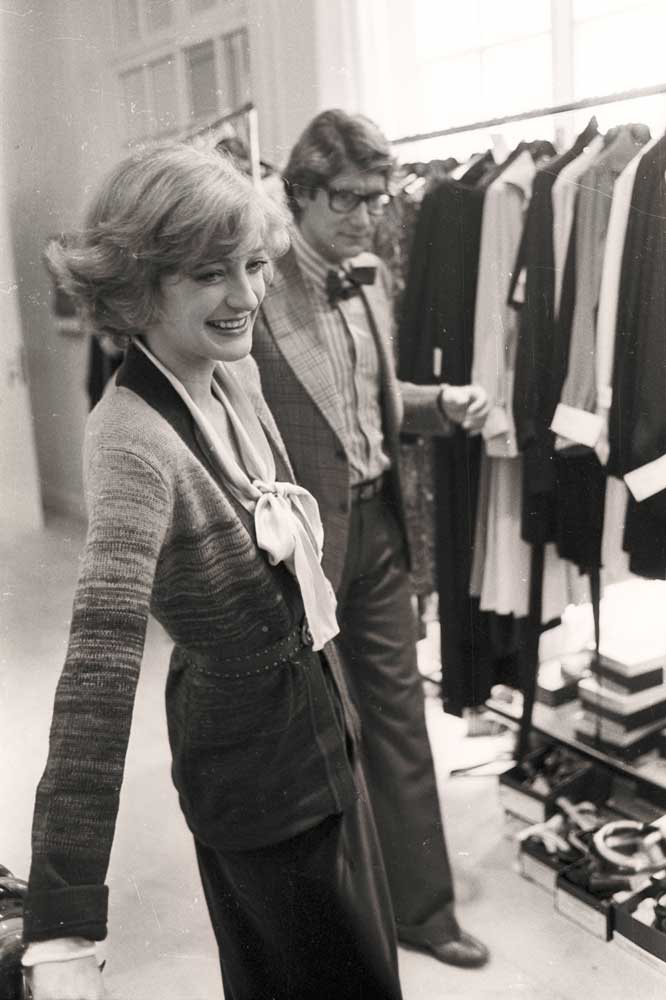
Loulou and Yves in his design studio.
But if the world knows Loulou best as Yves’s number two, her Irish roots were just as crucial to her identity: In my new biography of Loulou, Loulou & Yves: The Untold Story of Loulou de La Falaise and the House of Saint Laurent, her Irish connection is a major through-line. Untold is a little tabloid-y, I agree, but I promise there is nothing to prepare you for the professional, emotional and sexual cyclone that was her life, and the ghastly and unforeseen way it ended.
“Violet velvet trousers, a wreath of flowers on her head – that was Loulou,” the designer Fernando Sanchez said after meeting her in the 1960s, “like a fairy out of an Irish story book.” Hamish Bowles, the fashion historian, wrote that “through her birthright she inherited the whimsy and poetry of Ireland … Loulou brought the madcap spirit of bohemian Anglo-Irish aristocracy to Yves Saint Laurent’s elegant Parisian world, inspired him to … transform his own aesthetic realm, and by extension to literally change the way women wanted to look.” Loulou herself recalled travelling in Ireland, “on roads so beautiful yet sad, you come upon so many gypsies with their caravans, musical instruments, multicoloured clothes and jewels. I’ll always remember that mingling of adventure and nature.”
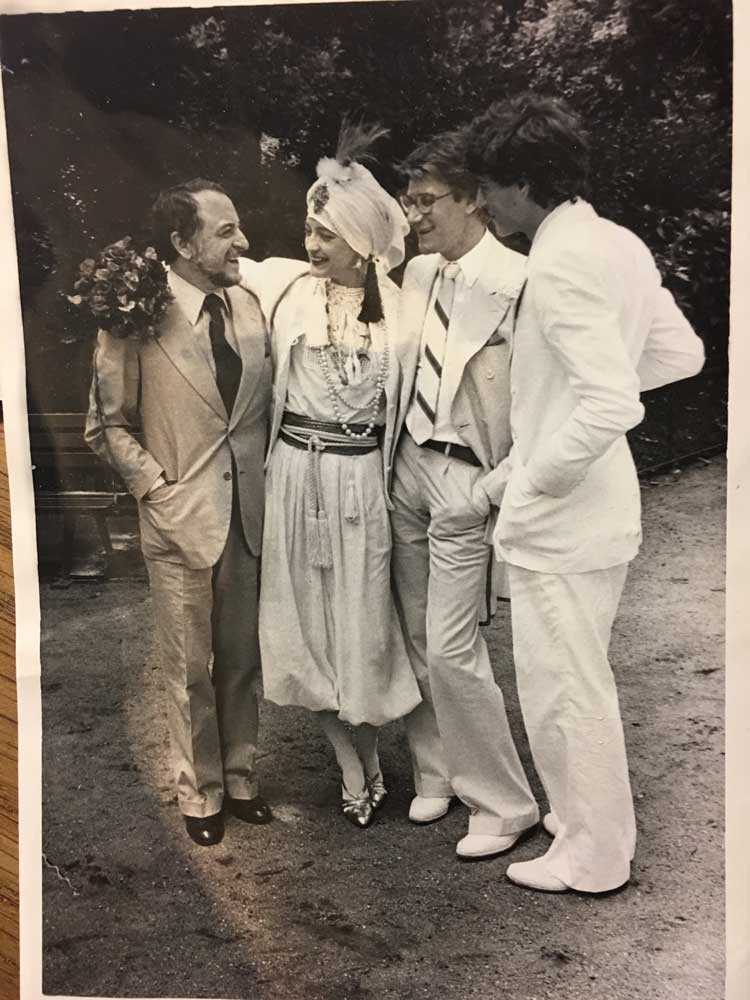
At her wedding in June 1977 to Thadée Klossowski, with Pierre Bergé and YSL.
Loulou had prickly relations with her Irish maternal grandmother, the menacingly eccentric Lady Rhoda Birley, and feckless mother, Maxime de La Falaise, but recognised their influence. “In her Mexican petticoats and piles of necklaces … [Rhoda] had the mysterious air of a fortune-teller – you could picture her around a campfire in Romania,” said Hubert de Givenchy. British Vogue’s Georgina Howell celebrated Maxime “as a young cropheaded comtesse, tall and thin enough to carry off the most extreme clothes of an extreme era,” a reference to her postwar years modelling at Schiaparelli. Looking back on his marriage to Loulou, Desmond FitzGerald said he’d “never seen anyone so captivated by fashion … Any excuse and out would come peacock feathers, strange belts, stage jewellery. Not that she spent a lot of money on clothes. It was all theatrical fantasy: She invented her own.”
Maxime, in fact, had no business calling herself a countess. Alain de La Falaise, Loulou’s deadbeat French father, was a cognac Hennessy on his mother’s side, but his paternity is disputed. Most of the La Falaise family keep to the line that Alain’s father was the Olympic fencing champion Gabriel de La Falaise – and a count. Which he was not, as two genealogists prove once and for all in Loulou & Yves.
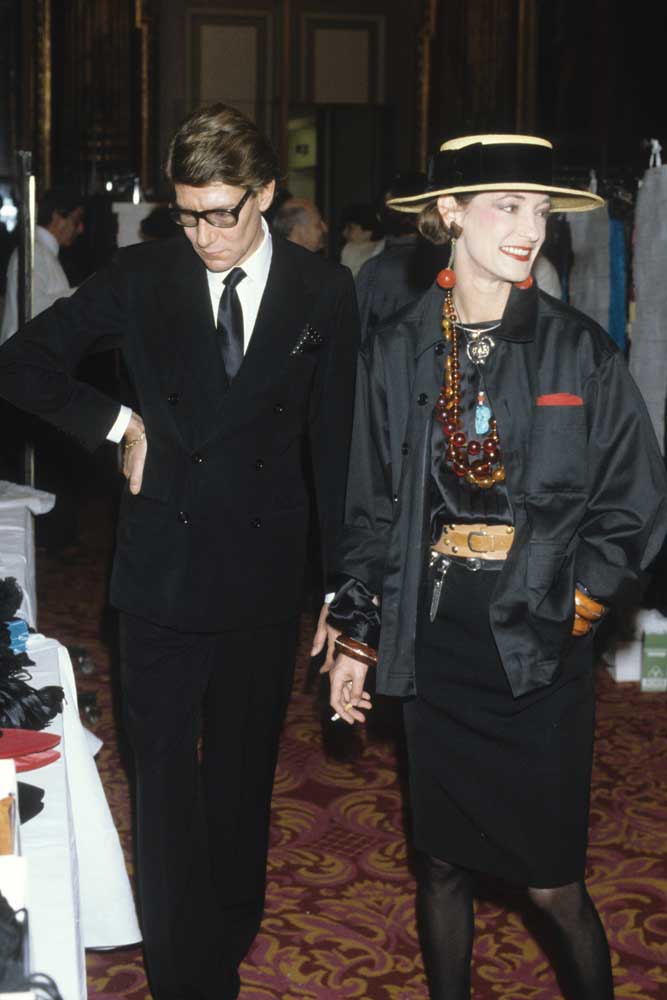
Loulou and Desmond’s decision to wed in 1966 was based on nothing so much as shared misery. She was all of 19, locked up with her crazy grandmother in Rhoda’s house in London; he was an assistant keeper in the furniture department at the V&A, already the jilted party in a broken-off engagement. Desmond suffered a bleak childhood, nannies and nursemaids filling in for unavailable parents. Veronica FitzGerald, née Villiers, was the Mother From Hell, skittish, pompous and the great-granddaughter of the 7th Duke of Marlborough, lineage that also allowed her to claim Churchill as a first cousin once removed.
Desmond’s first eight years were centred on Glin Castle, a rather plain bow-fronted, bay-backed late-18th-century Georgian pile, redeemed by a double flying staircase and ravishing Adamesque plasterwork, hard by the Shannon in Co Limerick. The house was later “Gothicised” with turrets, battlements, pepper-pot lodges and other toy effects, giving it the air of a child’s fort.
The estate came with a swashbuckling title: Knight of Glin. Passed through the male line and first documented in 1425, it was a tangle of sentimental hopes and gauzy certainties, maybe royal, or an Anglo-Irish adaptation of a Gaelic chieftainship, or … Descendants of the first knights were styled as such by acts of Parliament, and though the designation is recognised in Burke’s Landed Gentry of Ireland by virtue of patents under the Great Seal, it disappeared from Debrett’s in Desmond’s lifetime – after the 1980 edition, Irish hereditary knights were dropped in favour of peers and baronets only.
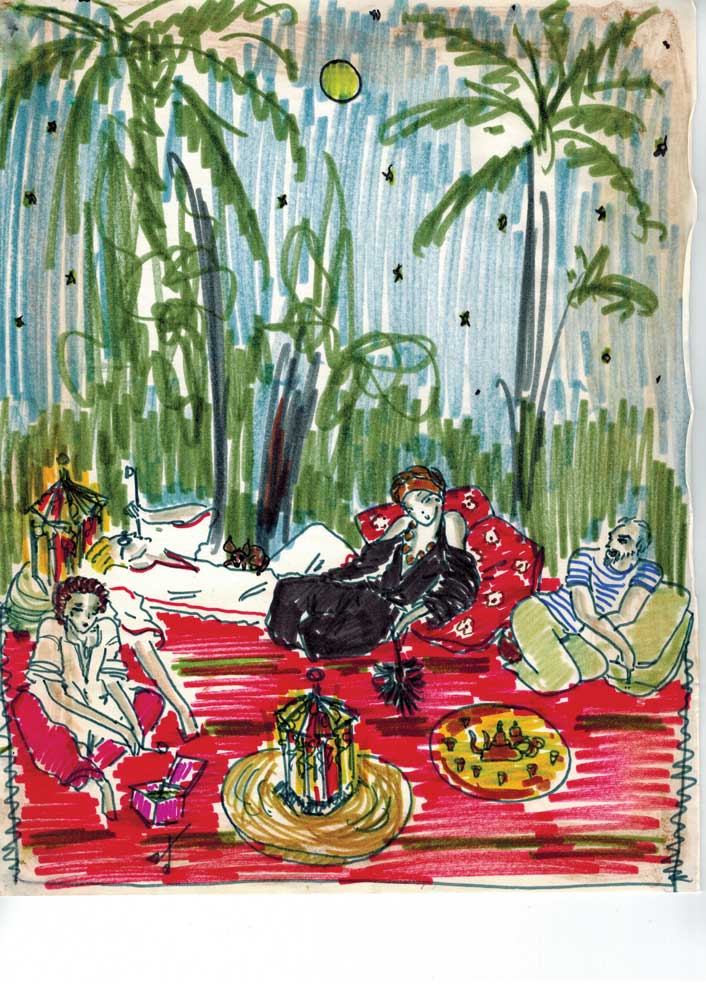
Drawing by Fernando Sanchez of himself, Yves, Loulou and Pierre Bergé in Marrakech in 1975.
Glin’s history was of scarce interest to a teenage bride, Loulou, who wore real medieval chainmail, nipples peeking through the links, and preferred tinkers to swells. One’s heart goes out to Desmond, who could recite the exploits of all 28 knights on demand, from the bloodthirsty bruisers of the Middle Ages to the landowning Anglo-Irish gentry of the Ascendancy. Glin in the 19th-century was a pleasure palace, the setting for regattas, champagne lunches and strawberry teas. By 1927, it could be reported that “The town of Glin … has this season become the resort of fashionables, for the pleasure of sea air and bathing.”
The knights courted bankruptcy; not that it showed. A few thousand acres could always be sold off to pay for “encumbrances.” Veronica, followed by Loulou, married into the “stranded gentry,” as the FitzGeralds’ social tranche was ruefully called after the Land Acts transferred property ownership in Ireland from landlord to tenant at the turn of the century. Glin would have gone down with a number of other great houses destroyed in the civil war if Desmond’s grandfather, confined to a wheelchair, hadn’t informed the IRA that they’d have to burn the castle down with him in it; the men retreated.
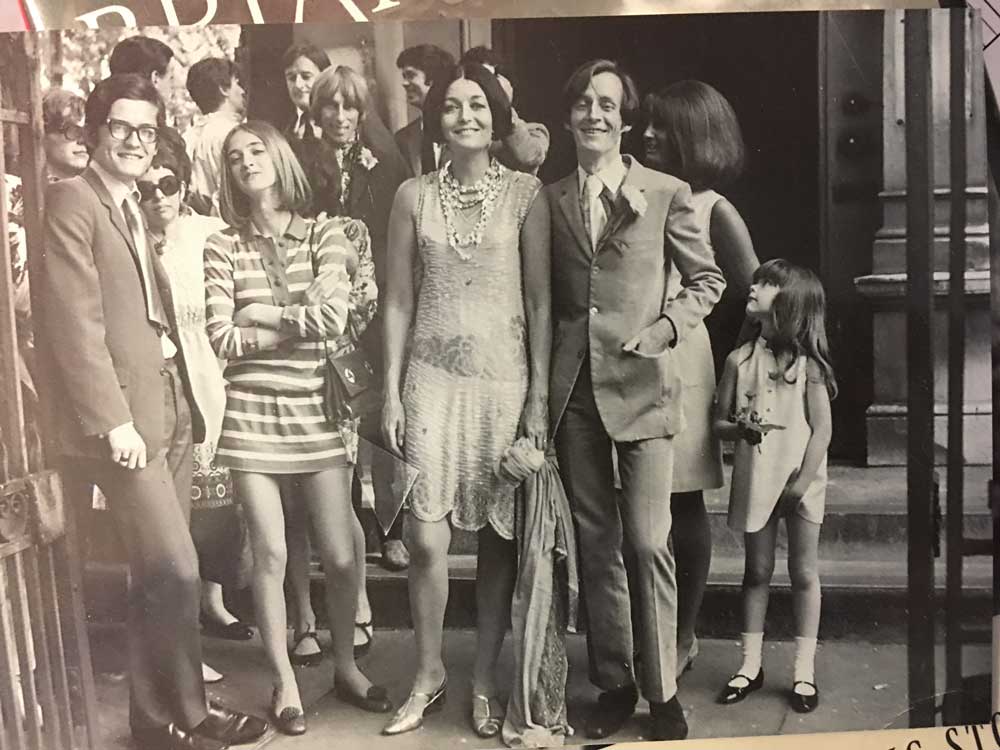
Loulou at the wedding of her mother Maxime and John McKendry in 1967. Also pictured is her brother Alexis and Lady Annabel Birley (behind McKendry).
Veronica was a certified monster, but she laboured to hold off the bailiffs, selling violets to Covent Garden, taking in paying guests. With the death of his father in 1949, Desmond found himself the twelve-year-old heir of a mouldering castle and a 500-acre estate of money-losing park and dairy land. At Harvard, he cultivated a reputation as a flâneur; in other words, he was becoming an aesthete. Back in Europe, he joined that momentous nucleus of tastemakers that included Desmond and Mariga Guinness, Christopher Gibbs, John Cornforth, Geoffrey Bennison, David Mlinaric and Min Hogg. As Glin’s new chatelain, the knight invited Mick Jagger and his girlfriend Marianne Faithfull for a weekend house party, and the village youths nearly fell out of windows following their progress down Church Street.
Loulou met Desmond at a poetry evening hosted by Rhoda and saw her ticket out of jail, alighting for the wedding ceremony at St Mary’s in London in a headpiece by Madame Rébé, “famous in Paris for coiffures de mariée,” Maxime wrote, “a little sort of beehive in creamy pearls to suspend the veil which we are draping over one shoulder ‘à l’irlandaise’!” The guest list was an aviary of the brightly-feathered drawn from Jennifer’s Diary, the Bottin Mondain and A Genealogical and Heraldic History of the Landed Gentry of Ireland: Cecil Beaton, Sacheverell Sitwell, Lady Diana Cooper, John Fowler, Osbert Lancaster, Patrick Lichfield photographing for various Vogues and the future “Acid Raine,” Princess Diana’s stepmother, Raine Spencer. Camilla Shand, Loulou’s exact contemporary, was 39 years away from marrying Prince Charles.
In its dispatch on the reception, American Vogue reported that “the Queen of the Tinkers sang, three Irish musicians played jigs, and a rock team named the Discords seemed, in their orange shirts and green ties, as dim as peahens among the peacock glory of the guests … Girls in pants suits. Men in ruffles. The mini-est skirts, long imposing satins, and something close to blue jeans: All were there …”
The magazine checked in with the FitzGeralds again a year later to see how they were getting on: “Desmond … has the eyes, arrogance, bearing, and look of imminently terrible temper, appropriate to the bearer of the oldest title in Ireland. His wild Celtic spirit meets its match in the Gallic-Saxon fire of his wife … the FitzGeralds are already formidable, granted that forgiving, admiring, fearful tolerance usually only given to ageing famous eccentrics. Madam FitzGerald, who gives the impression that she has just ground part of the populace under her foot …”
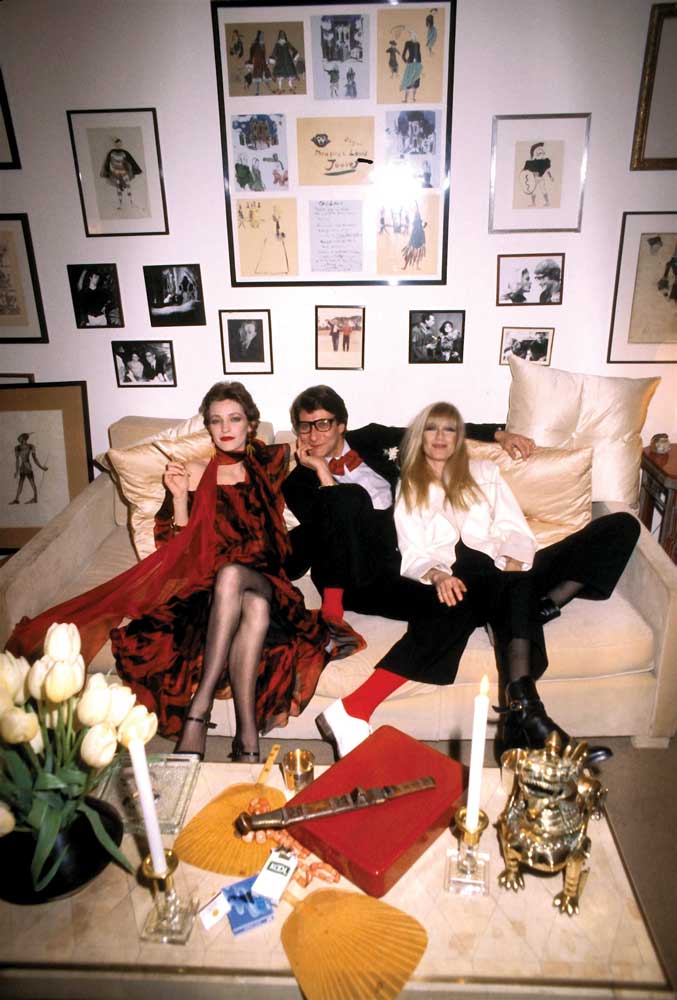
Muses Loulou de La Falaise and Betty Catroux photographed with Yves Saint Laurent in 1979 in Yves’s home on rue de Babylon, Paris, by Guy Marineau.
As Beaton’s accompanying portrait showed, Loulou and Desmond weren’t getting on at all: They look like they are about to kill each other.
“[Desmond] had a huge property without a penny,” Loulou remembered. “Americans came for the day. My husband gave talks. I went crazy … I used to walk along the battlements and scream into the night … I thought, This is not my life, I can’t do this forever … I never really saw my marriage as being forever, I must say … Then I had a scandalous love affair. With … somebody … with a man called Donald Cammell.”
Loulou left Desmond in 1968 for Cammell, who directed Jagger in Performance. In 1977 she married Thadée Klossowski. Thadée has proudly never done much with his life, happy to be forever known as “son of Balthus, the painter.” Desmond became Christie’s representative in Ireland and ran Glin as a hotel with his second wife Olda Willes. Olda has nothing but affection for Loulou, stating, “I can quite understand Glin seeming deadly. It’s an isolated, lonely place … So I couldn’t agree more with her. We had to close the hotel with the financial crises in the aughts and did what Desmond said he’d never do … and sold at Christie’s our silver, porcelains … Desmond had spent years buying back things previous knights had sold … and now he was selling them, too … finally conced[ing] that the whole Knight of Glin business was ‘a romantic charade’.”
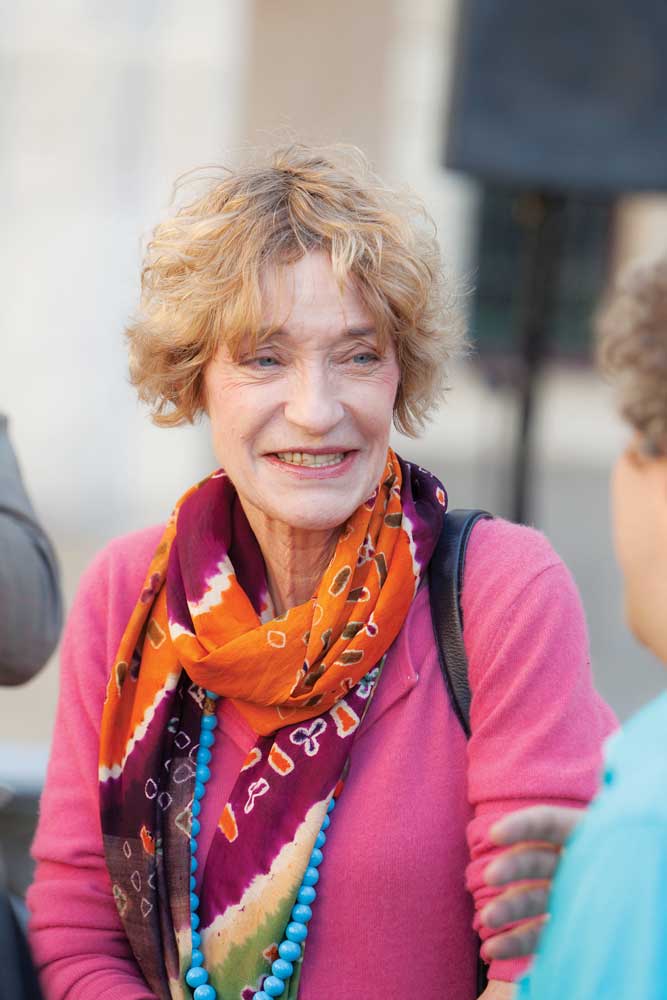
Loulou, in pink, in the last year of her life.
In 2017 the castle reopened under new management: the FitzGeralds’ daughter Catherine and her husband, the actor Dominic West. After Yves stepped down, Loulou launched herself as a designer under her own name with her own money. It was not a success. Bankruptcy forced the Klossowskis to give up their Paris apartment and move to their country house near Giverny full time; Loulou was also battling cirrhosis and liver cancer. The one person who could have stepped in and saved her, or at least helped her, was Pierre Bergé, Yves’s lover of many years and the business brains behind YSL. He did not.


Loulou & Yves: The Untold Story of Loulou de La Falaise and Yves Saint Laurent by Christopher Petkanas, St Martin’s Press, €30.61, is out now.
Pictured above: Christopher Petkanas
LOVETHEGLOSS.IE?
Sign up to our MAILING LIST now for a roundup of the latest fashion, beauty, interiors and entertaining news from THE GLOSS MAGAZINE’s daily dispatches.






